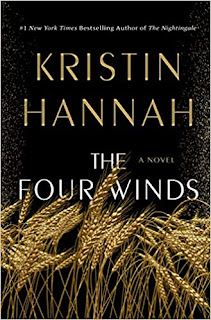The Four Winds by Kristin Hannah
The Dust Bowl during the 1930s was the worst environmental disaster in the US history, accompanied by the collapse of the economy and the effect of massive unemployment, resulting in massive migration of people from the Great Plains and other parts of the country to California. California was advertised as the land of milk and honey. Was it so?
Texas, 1921. Elsa Wolcott is twenty-five-years-old. She was a
sickly child forced to stay home and not able to finish her schooling. Within
the comfort of her own room, she continues to take adventures from the pages of
her books she devours. At her age, she is considered a spinster and unmarriageable
one as declared by her mother since men desire attractive women and Elsa is
not.
Dalhart in Texas is part of the flat, Great Plains stretching
as far as eyes could see, “a sea of prosperous land. (…) … A gold mind of wheat
and corn.” Despite the Great War, Dalhart experienced “booming economic times.”
This “making everyone in town rich,” including Elsa’s father. Thus, he doesn’t
understand why she needs education for when she asks to attend college in
Chicago to study literature.
1934. “Four years of drought, combined with the economic
ravages of the Great Depression, had brought the Great Plains to its knees.”
The land is bone-dry, completely useless, people are hungry, and animals are
lethargic, men feeling useless and unhappy leave families and head west to
California.
Loreda Martinelli, Elsa’s daughter, dreams about leaving the
dry lands for something bigger and more exciting. Loreda’s best friend is
leaving for Oregon with her family and she has to stay behind, because her
mother refuses to leave the land she loves. She despises her mother for not
wanting to leave this godforsaken land.
It was interesting to read about FDR’s plan to help farmers
and about farmers being stubborn and proud resisting FDR’s plan which was an
utter nonsense to them. They needed water; they didn’t need charity and someone
to tell them that they misused the land.
The hardship and the effects of years of dust and drought are
vividly presented. When farms are transported “into a sea of brown waves,”
after dust storms, you can see it and also feel the dust between your teeth and
in your eyes. The dust getting to people’s lungs and causing them dust
pneumonia. Them being left with nothing to provide for themselves and forced to
migrate west where there is promise of jobs.
It’s heart-wrenching to see people going through hardship due
to natural causes and combined with economic disaster. They follow the path
where promises are made of a better life. But as it turns out they’re not
welcomed there anymore. They are mistreated on the fields and out of the
fields. The hospitals are only for Californians who pay taxes and not for dirty
Okies.
When someone who has very little to pretty much nothing
shares whatever little they have with their neighbor is heart-warming. And
tries to explain all the injustice to a young mind. “When times is tough and
jobs is scarce, folks blame the outsiders. It’s human nature. (…) In California
it used to be the Mexicans, and the Chinese before that,” and now it’s Okies
from Texas, Oklahoma, and Kansas.
Elsa is a character that your heart goes to. She looks for
solace in books when dealing with overbearing parents. What she lacks in
nature, she finds in the novels – “to be bold, brave, beautiful, if only in her
own imagination.” She loves her husband and craves his love, but as she’s been
told from the childhood she is not pretty and that’s the reason. Her daughter despises
her, because she doesn’t have dreams. But Loreda doesn’t know about her
mother’s childhood and how her dreams were squashed by domineering parents.
Loreda dreams of becoming a writer and Elsa recognizes herself in her daughter.
Thus, she wants her daughter to go to college, to pursue her dreams and to be
happy.
Written with beautiful prose, vividly presented story of
hardship and comradery of ordinary people who show strength and resilience and
human spirit that touches your heart.
Release date: 2 February 2021
Source: St. Martin's Press

I'm nearing the end of this lovely book and continue to marvel at the effortless writing style. Hannah makes me want to read and read and I'm still trying to figure out how she's done that. The characters are brilliantly developed and the desire to hope for a better future drives the plotline. Gorgeous, gorgeous writing.
ReplyDelete